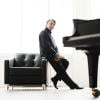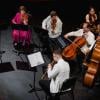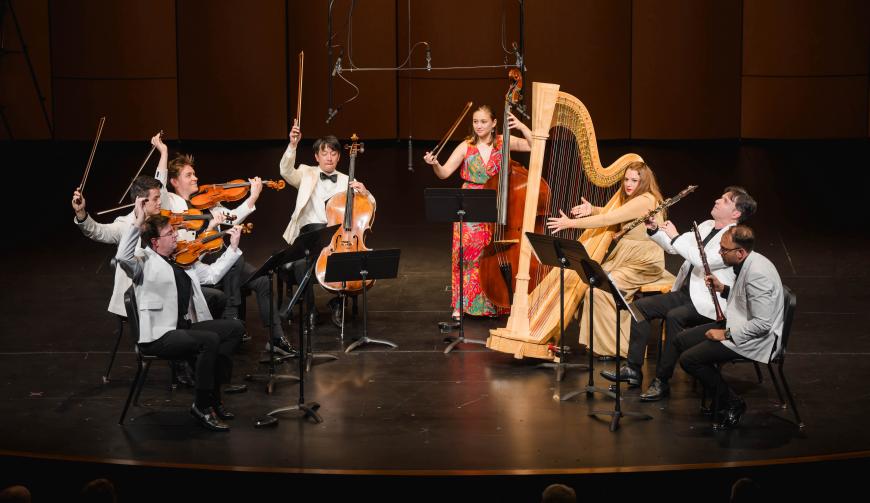
Music@Menlo’s mainstage concert on Saturday, July 27 expressed this summer’s theme — French chamber music in a broader context — by pairing French and American pieces composed between 1896 and 1936. The French works were by Maurice Ravel, the emblematic composer for this year’s festival. (The next day, Jean-Efflam Bavouzet gave a marathon recital of all of Ravel’s pieces for solo piano.)
The festival was fortunate in getting the Viano Quartet to play the sole string quartets of Ravel and Samuel Barber. The Viano players have an extraordinary facility with 20th-century music, and both of these pieces came out splendidly and with searing memorability.
The Viano took the bulk of Ravel’s well-known String Quartet in F Major with a light delicacy far removed from the torpor that the piece’s lurid harmonies can sometimes descend into. This approach, which came near to reverence in the slow movement, made a strong contrast with the music’s more energetic excursions. The beginning of the finale was fierce, even slashing, before relaxing into a gentler idiom. The scherzo begins with, and frequently returns to, bursts of pizzicato from all four instruments. It’s difficult to make pizzicato notes slash fiercely through the texture, but the Viano Quartet managed that.
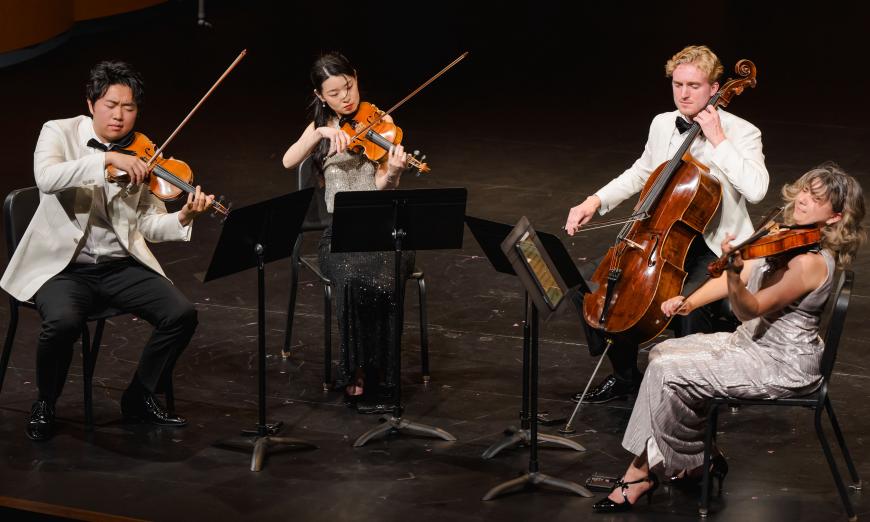
Barber’s String Quartet in B Minor, Op. 11, was an even finer performance. This piece is in the form of a sandwich, with two outer movements made of the same material: fast, crusty, and querulous. Nicholas Swett’s program notes use the term “chromatic squiggles” to describe the melodic line here. The creamy filling is the slow movement that Barber would later orchestrate as the famous Adagio for Strings.
The Viano Quartet surprised listeners with its treatment of both of the score’s modes. The outer movements, for all their squiggling, were strongly lyrical and melodic as well as declarative. They were filled with rich harmonies between the players and equally rich double stops produced individually.
The warm geniality in the outer movements prevented the Molto adagio from getting lost between them. Nor was this movement itself anything to be forgotten. This was a performance of gentle solemnity, with all the weight of the orchestral arrangement. The melodic line — starting on Lucy Wang’s first violin and elegantly passed on to Aiden Kane’s viola before being taken up in turn by the others — was smoothly carried out as it extended on and on, generating the feeling of breathing. After all, Barber was a major composer of vocal music.
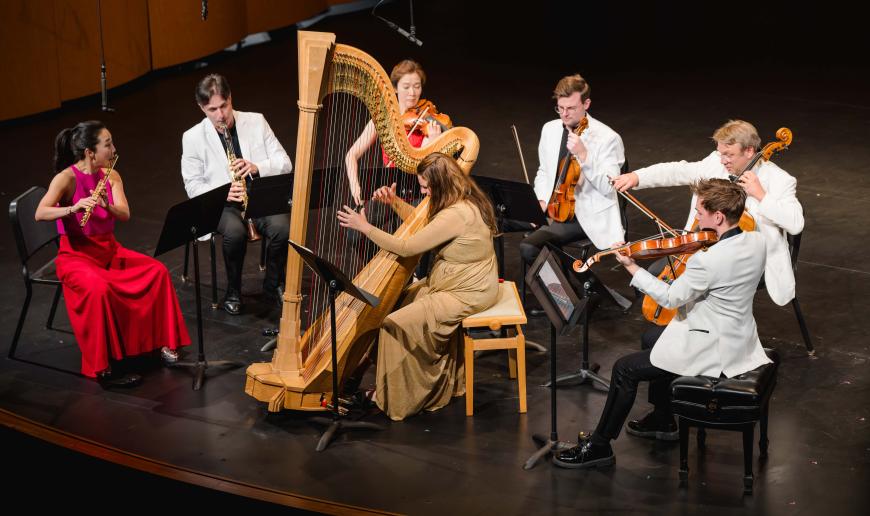
The other two works on the program were for large miscellaneous chamber ensembles including strings and harp. The string players here were a variety of performers from Menlo’s repertory company.
Ravel’s Introduction and Allegro, composed on commission from the Érard instrument makers to show off their double-action pedal harp, is functionally a brief harp concerto. Harpist Bridget Kibbey dominated the proceedings, not just sonically but also visually, placed at the front of the ensemble, with the string quartet, flute, and clarinet gathered around her. Kibbey displayed an impressive variety of tone colors, ranging from dry to resonant, especially in the cadenzas. The harp carries the melody through most of the piece, with some typically concerto-like accompanying display runs. The other musicians play mostly as a unit in support of the harp, though there are a sufficiency of solos.
Ravel’s septet was paired with an octet by Charles Martin Loeffler, recently unearthed after having been buried following its 1896 composition. Music@Menlo had to borrow the manuscript from the Library of Congress to make performing parts. This was the piece’s first performance on the West Coast.
Loeffler was an American composer and violinist, long a member of the Boston Symphony, born and raised in Germany. He considered Alsace, tucked between Germany and France, to be his place of origin; appropriately, his music sounds both German and French.
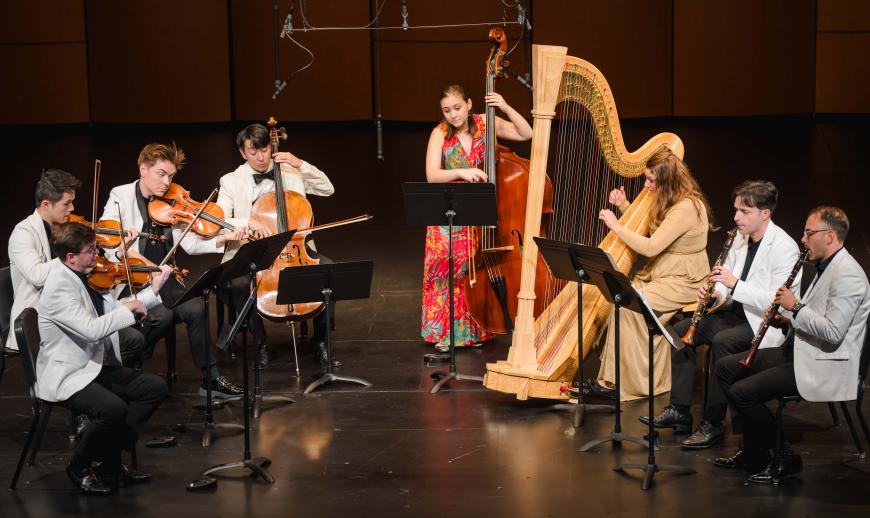
His Octet is an expansive piece, three movements and over half an hour long. Its instrumentation is close to Ravel’s. There’s a string quartet plus double bass, two clarinets (here played by Jose Franch-Ballester and Tommaso Lonquich), and harp (again played by Kibbey).
But it’s a chamber piece, not a concerto. The melodic line is traded between the quartet, playing as a group and in solos, and the clarinets, mostly playing together in harmony. The harp plays mostly occasional decoration, apart from a few surprises, like a striking passage in which it shares the melodic line with the clarinets. That’s until the finale, when the harp busts out all over with generous outbursts.
That’s not the only way Loeffler’s finale differs. His first two movements feature rich, complex harmony in a French style reminiscent of Claude Debussy — though lean rather than florid, despite the elaborate instrumentation. The finale, however, came out more German on Saturday, full of firmly tromping march episodes, plus a coda in the manner of the “Gypsy Rondo” from Brahms’s Piano Quartet No. 1, Op. 25. So the octet never ceased to surprise as the ensemble performed it most engagingly.


